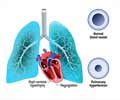According to the results of a trial in 42 countries, a drug therapy appears to reduce lung function loss in patients with moderate to severe chronic obstructive pulmonary disease (COPD).
Drug therapy appears to reduce lung function loss in patients with moderate to severe chronic obstructive pulmonary disease (COPD), a trial in 42 countries indicates.
The Toward a Revolution in COPD Health (TORCH) study investigated the effects of combined salmeterol, a B-agonist, and fluticasone propiniate, an inhaled cortical steroid, either alone or in combination, on mortality, exacerbations, health-related quality of life and rate of decline in lung function as measure by forced expiratory volume in one second (FEV1) in patients with COPD.The study has been published in the second issue for August of the American Journal of Respiratory and Critical Care Medicine, published by the American Thoracic Society.
"Pharmacotherapy with salmeterol plus fluticasone propionate, or the components, reduces the rate of decline on FEV1 in patients with moderate to severe COPD, thus slowing disease progression," said Bartolome R. Celli, M.D., lead author of the study and professor at Tufts University School of Medicine.
"To date, smoking cessation is the only intervention that has conclusively been shown to alter the rate of decline in FEV1," said Dr. Celli.
This is the first demonstration of an effective pharmacothrerapy in COPD.
The TORCH study randomized more than 6,000 patients with moderate to severe COPD from 42 countries to receive either salmeterol, fluticasone propionate, the two in combination, or placebo.
Advertisement
"The rate of decline in FEV1 was slowest in patients on SFC and fastest in those randomized to the placebo arm," said Dr. Celli.
Advertisement
Although the study was not formally powered to detect differences in rate of decline of FEV1, the results were highly significant. The rate of decline in treatment groups was similar across a number of variables, including sex, age, ethnicity and body mass index. Furthermore, the slower rate of decline in FEV1 appeared to be associated with a lower risk of exacerbation.
Source-ANI
RAS/N















